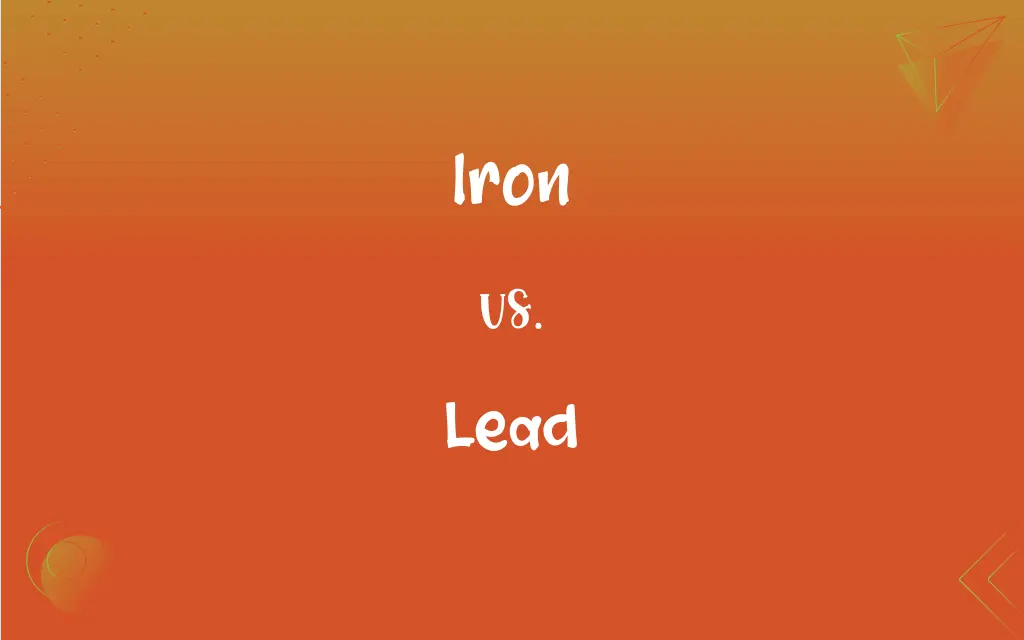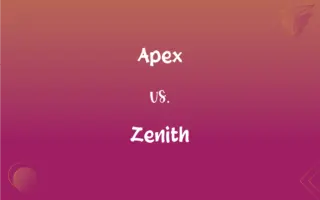Iron vs. Lead: What's the Difference?
Edited by Aimie Carlson || By Janet White || Updated on December 20, 2023
Iron is a strong, hard magnetic metal, used extensively in construction and manufacturing; lead is a heavy, soft, malleable metal, known for its toxicity and use in batteries and shielding.

Key Differences
Iron, a metallic element with the symbol Fe, is known for its strength, durability, and magnetic properties, making it essential in construction and manufacturing. Lead, with the symbol Pb, is a heavier, softer metal, known for its malleability and low melting point, but is toxic and used in more specialized applications like batteries and radiation shielding.
Iron is abundant in the earth's crust and is the main component of steel, an alloy critical to modern infrastructure and industry. Lead, less abundant, has historical uses in pipes and paint, but its use has decreased due to health concerns, though it remains important in battery production and radiation protection.
In terms of physical properties, iron is hard and magnetic, with a high melting point, making it ideal for structures and machinery. Lead, in contrast, is soft and easily shaped, with a low melting point, but its toxicity has limited its use, especially in consumer products.
Iron plays a crucial role in biology, being a key component of hemoglobin in blood, while lead is toxic to living organisms and can cause serious health issues if ingested or inhaled.
The industrial and commercial use of iron is widespread, from construction materials to automobiles, whereas lead, due to its toxicity, is used in more controlled and specific applications like in lead-acid batteries and X-ray shielding.
ADVERTISEMENT
Comparison Chart
Physical Properties
Strong, hard, magnetic.
Heavy, soft, malleable.
Use in Industry
Extensive in construction, machinery.
Batteries, radiation shielding, limited consumer use.
Abundance and Availability
More abundant in Earth's crust.
Less abundant, more restricted use.
Toxicity
Non-toxic, essential in biology.
Toxic, harmful to health.
Melting Point
Higher melting point.
Lower melting point.
ADVERTISEMENT
Iron and Lead Definitions
Iron
A device for pressing clothes.
She used an iron to smooth out the wrinkles in her shirt.
Lead
A clue or piece of information.
The detective followed a promising lead in the case.
Iron
To press and smooth with an iron.
He ironed his pants to look sharp for the meeting.
Lead
A heavy, soft, malleable metal.
The pipes in the old house were made of lead.
Iron
Iron golf clubs.
He chose a nine iron for the short shot to the green.
Lead
To go or guide in a direction.
She will lead the team in the upcoming project.
Iron
A strong, magnetic metallic element.
The bridge is reinforced with iron beams for extra strength.
Lead
The position at the front.
He took the lead in the race.
Iron
Symbolic of strength or hardness.
She had an iron will, never giving up in the face of adversity.
Lead
The main role in a play or film.
He landed the lead role in the new Broadway musical.
Iron
Symbol Fe A silvery-white, lustrous, malleable, ductile, magnetic or magnetizable, metallic element occurring abundantly in combined forms, notably in hematite, limonite, magnetite, and taconite, and used alloyed in a wide range of important structural materials. Atomic number 26; atomic weight 55.845; melting point 1,538°C; boiling point 2,861°C; specific gravity 7.874 (at 20°C); valence 2, 3, 4, 6. See Periodic Table.
Lead
To show the way to by going in advance
The host led us to our table.
Iron
An implement made of iron alloy or similar metal, especially a bar heated for use in branding, curling hair, or cauterizing.
Lead
To guide or direct in a course
Lead a horse by the halter.
FAQs
How is iron obtained?
Iron is extracted from iron ores in the earth's crust.
Can iron be toxic?
Excessive iron can be harmful, but it is generally non-toxic in normal amounts.
Is iron magnetic?
Yes, iron is naturally magnetic.
What is a lead-acid battery?
It's a type of battery that uses lead and sulfuric acid to store electrical energy.
What are the health benefits of iron?
Iron is essential for forming hemoglobin in blood, which carries oxygen.
What are the main uses of lead?
Lead is used in batteries, radiation shielding, and some alloys.
Is lead harmful to health?
Yes, lead is toxic and can cause serious health issues.
Are both iron and lead recyclable?
Yes, both metals are recyclable.
How is lead poisoning prevented?
By avoiding exposure to lead in paint, pipes, and contaminated soil.
What is iron primarily used for?
Iron is used in construction, manufacturing, and as a key component in steel.
Why has the use of lead decreased?
Due to its toxicity, the use of lead has decreased, especially in consumer products.
How do iron and lead differ in weight?
Lead is heavier and denser than iron.
Can iron rust?
Yes, iron can rust when exposed to oxygen and moisture.
What is the symbol for iron?
The chemical symbol for iron is Fe.
What is the symbol for lead?
The chemical symbol for lead is Pb.
What role does iron play in the environment?
Iron is a natural part of the earth's crust and is essential for plant growth.
Is lead used in construction?
Lead's use in construction has decreased due to health risks.
Can lead be found in nature?
Yes, lead is naturally occurring but less abundant than iron.
Can iron be alloyed with other metals?
Yes, iron is commonly alloyed to make steel.
Why is lead used in radiation shielding?
Lead is effective at blocking radiation due to its high density.
About Author
Written by
Janet WhiteJanet White has been an esteemed writer and blogger for Difference Wiki. Holding a Master's degree in Science and Medical Journalism from the prestigious Boston University, she has consistently demonstrated her expertise and passion for her field. When she's not immersed in her work, Janet relishes her time exercising, delving into a good book, and cherishing moments with friends and family.
Edited by
Aimie CarlsonAimie Carlson, holding a master's degree in English literature, is a fervent English language enthusiast. She lends her writing talents to Difference Wiki, a prominent website that specializes in comparisons, offering readers insightful analyses that both captivate and inform.































































